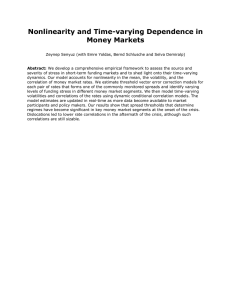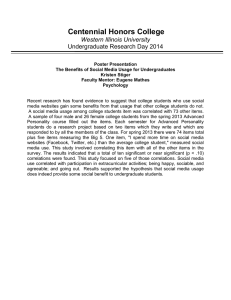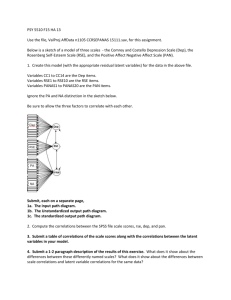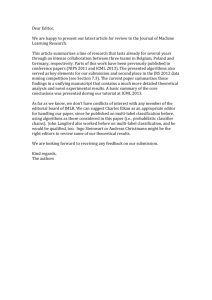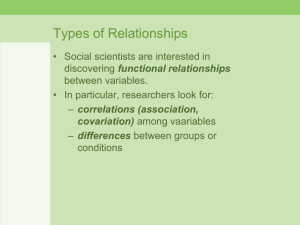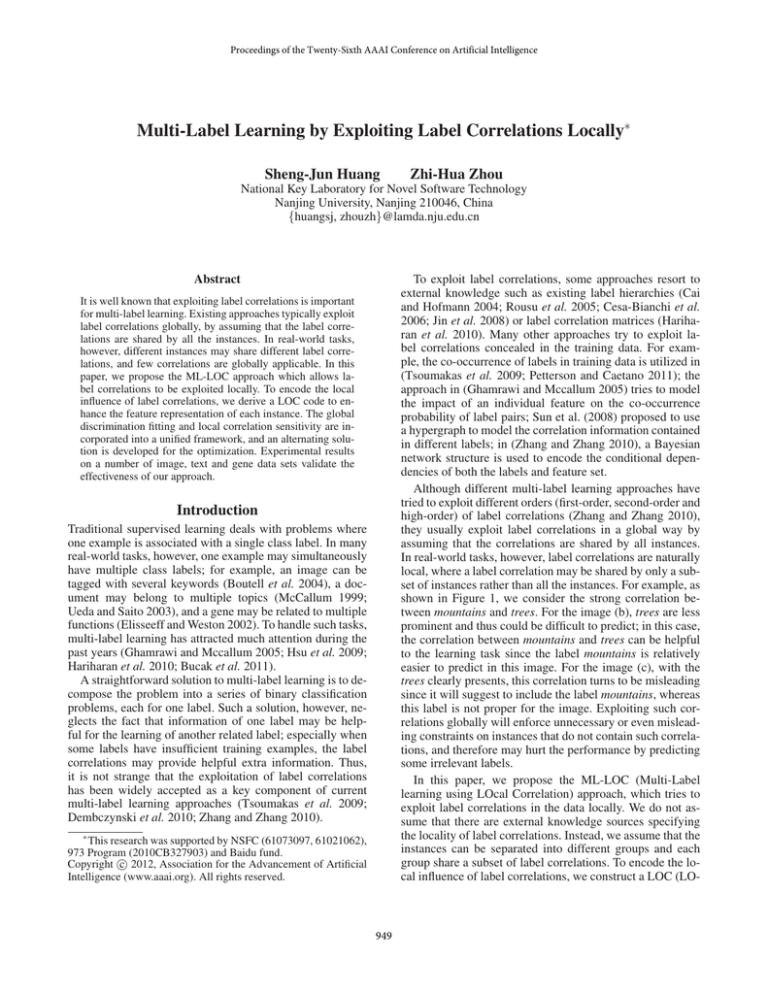
Proceedings of the Twenty-Sixth AAAI Conference on Artificial Intelligence
Multi-Label Learning by Exploiting Label Correlations Locally∗
Sheng-Jun Huang
Zhi-Hua Zhou
National Key Laboratory for Novel Software Technology
Nanjing University, Nanjing 210046, China
{huangsj, zhouzh}@lamda.nju.edu.cn
Abstract
To exploit label correlations, some approaches resort to
external knowledge such as existing label hierarchies (Cai
and Hofmann 2004; Rousu et al. 2005; Cesa-Bianchi et al.
2006; Jin et al. 2008) or label correlation matrices (Hariharan et al. 2010). Many other approaches try to exploit label correlations concealed in the training data. For example, the co-occurrence of labels in training data is utilized in
(Tsoumakas et al. 2009; Petterson and Caetano 2011); the
approach in (Ghamrawi and Mccallum 2005) tries to model
the impact of an individual feature on the co-occurrence
probability of label pairs; Sun et al. (2008) proposed to use
a hypergraph to model the correlation information contained
in different labels; in (Zhang and Zhang 2010), a Bayesian
network structure is used to encode the conditional dependencies of both the labels and feature set.
Although different multi-label learning approaches have
tried to exploit different orders (first-order, second-order and
high-order) of label correlations (Zhang and Zhang 2010),
they usually exploit label correlations in a global way by
assuming that the correlations are shared by all instances.
In real-world tasks, however, label correlations are naturally
local, where a label correlation may be shared by only a subset of instances rather than all the instances. For example, as
shown in Figure 1, we consider the strong correlation between mountains and trees. For the image (b), trees are less
prominent and thus could be difficult to predict; in this case,
the correlation between mountains and trees can be helpful
to the learning task since the label mountains is relatively
easier to predict in this image. For the image (c), with the
trees clearly presents, this correlation turns to be misleading
since it will suggest to include the label mountains, whereas
this label is not proper for the image. Exploiting such correlations globally will enforce unnecessary or even misleading constraints on instances that do not contain such correlations, and therefore may hurt the performance by predicting
some irrelevant labels.
In this paper, we propose the ML-LOC (Multi-Label
learning using LOcal Correlation) approach, which tries to
exploit label correlations in the data locally. We do not assume that there are external knowledge sources specifying
the locality of label correlations. Instead, we assume that the
instances can be separated into different groups and each
group share a subset of label correlations. To encode the local influence of label correlations, we construct a LOC (LO-
It is well known that exploiting label correlations is important
for multi-label learning. Existing approaches typically exploit
label correlations globally, by assuming that the label correlations are shared by all the instances. In real-world tasks,
however, different instances may share different label correlations, and few correlations are globally applicable. In this
paper, we propose the ML-LOC approach which allows label correlations to be exploited locally. To encode the local
influence of label correlations, we derive a LOC code to enhance the feature representation of each instance. The global
discrimination fitting and local correlation sensitivity are incorporated into a unified framework, and an alternating solution is developed for the optimization. Experimental results
on a number of image, text and gene data sets validate the
effectiveness of our approach.
Introduction
Traditional supervised learning deals with problems where
one example is associated with a single class label. In many
real-world tasks, however, one example may simultaneously
have multiple class labels; for example, an image can be
tagged with several keywords (Boutell et al. 2004), a document may belong to multiple topics (McCallum 1999;
Ueda and Saito 2003), and a gene may be related to multiple
functions (Elisseeff and Weston 2002). To handle such tasks,
multi-label learning has attracted much attention during the
past years (Ghamrawi and Mccallum 2005; Hsu et al. 2009;
Hariharan et al. 2010; Bucak et al. 2011).
A straightforward solution to multi-label learning is to decompose the problem into a series of binary classification
problems, each for one label. Such a solution, however, neglects the fact that information of one label may be helpful for the learning of another related label; especially when
some labels have insufficient training examples, the label
correlations may provide helpful extra information. Thus,
it is not strange that the exploitation of label correlations
has been widely accepted as a key component of current
multi-label learning approaches (Tsoumakas et al. 2009;
Dembczynski et al. 2010; Zhang and Zhang 2010).
∗
This research was supported by NSFC (61073097, 61021062),
973 Program (2010CB327903) and Baidu fund.
c 2012, Association for the Advancement of Artificial
Copyright Intelligence (www.aaai.org). All rights reserved.
949
loss function V as the summarization of losses across all the
labels:
XL
V (xi , ci , yi , f ) =
loss(xi , ci , yil , fl ),
(2)
l=1
(a) mountains,
trees, sky, river
(b) mountains,
sky, river, trees
where loss(x, c, y, f ) = max{0, 1 − yf ([φ(x), c])} is the
Hinge loss in SVM. For the second term of Eq. 1, we simply
implement it as:
XL
Ω(f ) =
||wl ||2 .
(3)
(c) trees, desert,
sky, camel
Figure 1: Illustration of non-global label correlations.
l=1
The third term of Eq. 1 is utilized to enforce that similar instances have similar codes. With the previous discussion we know that for a specific instance, only a subset of
label correlations are helpful whereas the others are less
informative or even harmful, and similar instances share
the same label correlations. We assume that the training
data can be separated into m groups {G1 , G2 , · · · , Gm },
where instances in the same group share the same subset
of label correlations. Inspired by (Zhou and Zhang 2007;
Zhou et al. 2012), the groups can be discovered via clustering. Correspondingly, we denote by Sj the subset of correlations that are shared by the instances in Gj . Since label correlations are usually unavailable and very difficult to obtain,
we instead represent Sj with a prototype of all the instances
in Gj , denoted by pj . As in Eq. 4, we generate the prototype pj in the label space by averaging the label vectors of
the instances in Gj :
1 X
pj =
yk ,
(4)
xk ∈Gj
|Gj |
cal Correlation) code for each instance and use this code as
additional features for the instance. We formulate the problem by incorporating global discrimination fitting and local
correlation sensitivity into a unified framework, and develop
an alternating solution for the optimization. The effectiveness of ML-LOC is validated in experiments.
We propose the ML-LOC approach in the next section,
and then present our experiments, followed by the conclusion.
The ML-LOC Approach
The Framework
Let X = Rd be the input space and Y = {−1, +1}L
be the label space with L possible labels. We denote
by {(x1 , y1 ), (x2 , y2 ), · · · , (xn , yn )} the training data that
consists of n instances, where each instance xi =
[xi1 , xi2 , · · · , xid ] is a vector of d dimensions and yi =
[yi1 , yi2 , · · · , yiL ] is the label vector of xi , yil is +1 if xi
has the l-th label and −1 otherwise. The goal is to learn a
function f : X → Y which can predict the label vectors for
unseen instances.
We introduce a code vector ci for each instance xi to encode the local influence of label correlations, and expand
the original feature representation with the code. Since similar instances share the same subset of label correlations, the
code is expected to be local, i.e., similar instances will have
similar c. Notice that we measure the similarity between instances in the label space rather than in the feature space
because instances with similar label vectors usually share
the same correlations. For simplicity, we assume f consists
of L functions, one for a label, i.e., f = [f1 , f2 , · · · , fL ],
and each fl is a linear model: fl (x, c) = hwl , [φ(x), c]i =
hwlx , φ(x)i + hwlc , ci, where h·, ·i is the inner production,
φ(·) is a feature mapping induced by a kernel κ, and wl =
[wlx , wlc ] is the weight vector. Here wlx and wlc are the two
parts of wl corresponding to the original feature vector x
and the code c, respectively. Aiming to the global discrimination fitting and local correlation sensitivity, we optimize
both f and C such that the following function is minimized:
Xn
min
V (xi , ci , yi , f ) + λ1 Ω(f ) + λ2 Z(C)
(1)
f ,C
where |Gj | is the number of instances in Gj . Then, given an
instance xi , we define cij to measure the local influence of
Sj on xi . The more similar yi and pj , the more likely that
xi shares the same correlations with instances in Gj , suggesting a larger value of cij and implying a higher probability that Sj is helpful to xi . We name the concatenated vector
ci = [ci1 , ci2 , · · · , cim ] LOC code (LOcal Correlation code)
for xi , and define the regularizer term on the LOC codes as:
n X
m
X
Z(C) =
cij ||yi − pj ||2 .
(5)
i=1 j=1
By substituting Eqs. 2, 3 and 5 into Eq. 1, the framework
can be rewritten as:
n X
L
L
X
X
min
ξil + λ1
||wl ||2
W,C,P
i=1 l=1
n X
m
X
+ λ2
l=1
cij ||yi − pj ||2
(6)
i=1 j=1
s.t.
i=1
where V is the loss function defined on the training data, Ω
is a regularizer to control the complexity of the model f , Z
is a regularizer to enforce the locality of the codes C, and λ1
and λ2 are parameters trading off the three terms.
Among the different multi-label losses, in this paper, we
focus on the commonly used hamming loss and define the
yil hwl , [φ(xi ), ci ]i ≥ 1 − ξil
ξil ≥ 0 ∀i ∈ {1, · · · , n}, l ∈ {1, · · · , L}
Xm
cij = 1 ∀i ∈ {1, · · · , n}
j=1
0 ≤ cij ≤ 1 ∀i ∈ {1, · · · , n}, j ∈ {1, · · · , m}
cij measures the probability that Sj is helpful to xi , thus,
it is constrained to be in the interval [0, 1], and the sum of
each ci is constrained to be 1.
950
The Alternating Solution
Algorithm 1 The ML-LOC algorithm
1: INPUT:
2:
training set {X, Y }, parameters λ1 , λ2 and m
3: TRAIN:
4:
initialize P and C with k-means
5:
repeat:
6:
optimize W according to Eq. 7
7:
optimize C according to Eq. 9
8:
update P according to Eq. 11
9:
until convergence
10:
for j=1:m
11:
train a regression model Rj
12:
for the j-th dimension of LOC codes
13:
end for
14: TEST:
15:
predict the LOC codes: ctj ← Rj (φ(xt ))
16:
predict the labels: ytl ← hwl , [φ(xt ), ct ]i
We solve the optimization problem in Eq. 6 in an alternating
way, i.e., optimizing one of the three variables with the other
two fixed. When we fix C and P to solve W , the third term
of Eq. 6 is a constant and thus can be ignored, then Eq. 6 can
be rewritten as:
min
W
n X
L
X
ξil + λ1
i=1 l=1
L
X
||wl ||2
(7)
l=1
yil hwl , [φ(xi ), ci ]i ≥ 1 − ξil
ξil ≥ 0 ∀i = {1, · · · , n}, l = {1, · · · , L}
s.t.
Notice that Eq. 7 can be further decomposed into L optimization problems, where the l-th one is:
min
wl
n
X
ξil + λ1 ||wl ||2
(8)
i=1
yil hwl , [φ(xi ), ci ]i ≥ 1 − ξil
ξil ≥ 0 ∀i = {1, · · · , n}
s.t.
test instance xt , its LOC code ct is unknown. We thus train
m regression models on the training instances and their LOC
codes, one for a dimension of LOC codes. Then, in testing
phase, the LOC code of the test instance can be obtained
from the outputs of regression models. Notice that the regression models can be trained with a low computational
cost because usually m is not large.
The pseudo code of ML-LOC is presented in Algorithm 1.
P and C are initialized with the result of k-means clustering
on the label vectors. In detail, the label vectors are clustered
into m clusters and the prototype pk is initialized with the
center of the k-th cluster. cik is assigned 1 if yi is in the k-th
cluster and 0 otherwise. Here k-means is used simply because its popularity; ML-LOC can be facilitated with other
clustering approaches. Then W , C and P are updated alternatingly. Since Eq. 6 is lower bounded, it will converge
to a local minimum. After that, m regression models are
trained with the original features as inputs and the LOC
codes as outputs. Given a test instance xt , the LOC code
ct = [ct1 , ct2 , · · · , ctm ] is firstly obtained with the regression models. Then the final label vector yt is obtained by
ytl = hwl , [φ(xt ), ct ]i.
which is a standard SVM model. So, W can be optimized
by independently training L SVM models.
When we fix W and P to solve C, the task becomes:
min
C
s.t.
L
n X
X
ξil + λ2
n X
m
X
cij ||yi − pj ||2
(9)
i=1 j=1
i=1 l=1
yil hwl , [φ(xi ), ci ]i ≥ 1 − ξil
ξil ≥ 0 ∀i = {1, · · · , n}, l = {1, · · · , L}
Xm
cij = 1 ∀i = {1, · · · , n}
j=1
0 ≤ cij ≤ 1 ∀i = {1, · · · , n}, j = {1, · · · , m}
Again, Eq. 9 can be decomposed into n optimization
problems, and the i-th one is:
min
ci
s.t.
L
X
ξil + λ2
m
X
cij ||yi − pj ||2
(10)
j=1
l=1
yil hwlc , ci i ≥ 1 − ξil − yil hwlx , φ(xi )i
ξil ≥ 0 ∀l = {1, · · · , L}
Xm
cij = 1
Experiments
j=1
Comparison with State-of-the-Art Approaches
0 ≤ cij ≤ 1 ∀j = {1, · · · , m}
To examine the effectiveness of LOC codes, ML-LOC is
firstly compared with BSVM (Boutell et al. 2004), which
learns a binary SVM for each label, and can be considered
as a degenerated version of ML-LOC without LOC codes.
ML-LOC is also compared with three other state-of-theart multi-label methods: ML-kNN (Zhang and Zhou 2007)
which considers first-order correlations, RankSVM (Elisseeff and Weston 2002) which considers second-order correlations and ECC (Read et al. 2011) which considers higherorder correlations. Finally, we construct another baseline
ECC-LOC, by feeding the new feature vectors expanded
with LOC codes into ECC as input. For the compared methods, the parameters recommended in the corresponding literatures are used. For ML-LOC, parameters are fixed for all
which is a linear programming and can be solved efficiently.
After the training, the c’s reflect the similarities between the
labels and the prototypes; the larger the similarity, the larger
the corresponding element of c. Due to page limit, we will
show some examples in a longer version.
Finally, as W and C are updated, the belongingness of
each instance xi to each group Gj may be changed, so the
prototype P is correspondingly updated according to:
Xn
pj =
cij yi .
(11)
i=1
Notice that the classification models are trained based on
both the original feature vector and the LOC codes. Given a
951
Table 1: Results (mean±std.) on image data sets. •(◦) indicates that ML-LOC is significantly better(worse) than the corresponding method on the criterion based on paired t-tests at 95% significance level. ↑(↓) implies the larger(smaller), the better.
data
image
scene
corel5K
criteria
hloss ↓
one-error ↓
coverage ↓
rloss ↓
aveprec ↑
hloss ↓
one-error ↓
coverage ↓
rloss ↓
aveprec ↑
hloss ↓
one-error ↓
coverage ↓
rloss ↓
aveprec ↑
ML-LOC
.156±.007
.277±.022
.175±.015
.152±.017
.819±.014
.076±.003
.179±.010
.069±.008
.065±.009
.891±.008
.009±.000
.638±.010
.474±.013
.218±.008
.294±.005
BSVM
.179±.006•
.291±.016•
.181±.010•
.161±.009•
.808±.010•
.098±.002•
.209±.014•
.073±.005•
.070±.005•
.876±.008•
.009±.000•
.768±.009•
.316±.003◦
.141±.002◦
.214±.003•
ML-kNN
.175±.007•
.325±.024•
.194±.012•
.177±.013•
.788±.014•
.090±.003•
.238±.012•
.084±.005•
.083±.006•
.857±.007•
.009±.000•
.740±.011•
.307±.003◦
.135±.002◦
.242±.005•
the data sets as: λ1 = 1, λ2 = 100 and m = 15. LibSVM
(Chang and Lin 2011) is used to implement the SVM models
for both ML-LOC and BSVM.
We evaluate the performances of the compared approaches with five commonly used multi-label criteria: hamming loss, one error, coverage, ranking loss and average
precision. These criteria measure the performance from different aspects and the detailed definitions can be found in
(Schapire and Singer 2000; Zhou et al. 2012). Notice that
we normalize the coverage by the number of possible labels
such that all the evaluation criteria vary between [0, 1].
We study the effectiveness of ML-LOC on seven multilabel data sets from three kinds of tasks: image classification, text analysis and gene function prediction. In the following experiments, on each data set, we randomly partition
the data into the training and test sets for 30 times, and report the average results as well as standard deviations over
the 30 repetitions.
RankSVM
.339±.021•
.708±.052•
.420±.013•
.463±.018•
.516±.011•
.251±.017•
.457±.065•
.192±.032•
.214±.039•
.698±.047•
.012±.001•
.977±.018•
.735±.036•
.408±.035•
.067±.007•
ECC
.180±.010•
.300±.022•
.200±.011•
.247±.016•
.789±.014•
.095±.004•
.232±.011•
.095±.004•
.139±.008•
.846±.007•
.014±.000•
.666±.008•
.746±.007•
.601±.006•
.227±.004•
ECC-LOC
.165±.008•
.249±.020◦
.201±.011•
.297±.022•
.805±.011•
.075±.004
.152±.009◦
.098±.006•
.201±.011•
.871±.006•
.015±.000•
.674±.012•
.809±.007•
.702±.007•
.194±.005•
the LOC codes. It is noteworthy that BSVM outperforms
ECC on the scene data set on all the five criteria. This interesting observation will be further studied later in this paper. Finally, when looking at ECC-LOC, its performances
are worse than or comparable with ML-LOC. This is reasonable because most helpful local correlations have already
been captured in the LOC codes, and thus little additional
gains or even misleading information could be obtained by
exploiting global correlations.
Text Data Medical is a data set of clinical texts for medical classification. There are 978 instances and 45 possible
labels. Enron is a subset of the Enron email corpus (Klimt
and Yang 2004), including 1702 emails with 53 possible labels. Results on these text data sets are summarized in Table 2. It can be seen that the comparison results are similar as
that on the image data sets. ML-LOC outperforms the baselines in most cases, especially on hamming loss and average
precision. ECC has advantages on one error, but achieves
suboptimal performances on other criteria.
Image Data We first perform the experiments on three image classification data sets: image, scene and corel5k. They
have 2000, 2407, 5000 images, and 5, 6, 374 possible labels, respectively. The performances on five evaluation criteria are summarized in Table 1. Notice that for average precision, a larger value implies a better performance, whereas
for the other four criteria, the smaller, the better. First, we exclude ECC-LOC, and compare ML-LOC with the baselines
without considering local correlations. On hamming loss, for
which ML-LOC is designed to optimize, our approach outperforms the other approaches significantly on all the three
data sets. Although ML-LOC does not aim to optimize the
other four evaluation criteria, it still achieves the best performance in most cases. Comparing with BSVM, which is a
degenerated version of ML-LOC without LOC codes, MLLOC is always superior to BSVM except for the coverage
and ranking loss on corel5K, verifying the effectiveness of
Gene Data Genebase is a data set for protein classification; it has 662 instances and 27 possible labels. Yeast
is a data set for predicting the gene functional classes of
the Yeast Saccha-romyces cerevisiae, containing 2417 genes
and 14 possible labels. Table 3 shows the results. Again,
ML-LOC achieves decent performance and is significantly
superior to the compared approaches in most cases. ECC
achieves the best performance on one error, but is less effective on the other criteria. One possible reason is that ECC
utilize label correlations globally on all the instances and
may predict some irrelevant labels for some instances that
do not share the correlations. The incorrect predictions may
be ranked after some very confident correct predictions, and
thus do not affect the one error which cares only the topranked label, whereas leading to worse performances on the
other criteria.
952
Table 2: Results (mean±std.) on text data sets. •(◦) indicates that ML-LOC is significantly better(worse) than the corresponding
method on the criterion based on paired t-tests at 95% significance level. ↑(↓) implies the larger(smaller), the better.
data
medical
enron
criteria
hloss ↓
one-error ↓
coverage ↓
rloss ↓
aveprec ↑
hloss ↓
one-error ↓
coverage ↓
rloss ↓
aveprec ↑
ML-LOC
.010±.001
.135±.015
.032±.006
.021±.004
.898±.009
.048±.002
.257±.034
.314±.017
.113±.009
.662±.019
BSVM
.020±.001•
.290±.026•
.055±.006•
.041±.005•
.776±.017•
.056±.002•
.359±.033•
.294±.017◦
.115±.008
.578±.019•
ML-kNN
.016±.001•
.275±.023•
.060±.007•
.043±.006•
.788±.017•
.051±.002•
.299±.031•
.246±.016◦
.091±.008◦
.636±.015•
RankSVM
.038±.001•
.735±.020•
.156±.007•
.141±.006•
.394±.016•
.311±.367•
.855±.020•
.500±.025•
.267±.019•
.262±.017•
ECC
.010±.001
.110±.016◦
.071±.008•
.109±.014•
.866±.014•
.055±.002•
.228±.036◦
.391±.021•
.246±.018•
.637±.021•
ECC-LOC
.010±.001
.104±.014◦
.094±.012•
.162±.022•
.831±.018•
.055±.003•
.212±.035◦
.442±.024•
.294±.019•
.621±.023•
Table 3: Results (mean±std.) on gene data sets. •(◦) indicates that ML-LOC is significantly better(worse) than the corresponding method on the criterion based on paired t-tests at 95% significance level. ↑(↓) implies the larger(smaller), the better.
data
genebase
yeast
criteria
hloss ↓
one-error ↓
coverage ↓
rloss ↓
aveprec ↑
hloss ↓
one-error ↓
coverage ↓
rloss ↓
aveprec ↑
ML-LOC
.001±.000
.004±.003
.010±.002
.001±.001
.997±.002
.187±.002
.216±.010
.451±.006
.162±.004
.777±.005
BSVM
.005±.001•
.004±.003
.013±.003•
.002±.001•
.995±.002•
.189±.003•
.217±.011
.461±.005•
.169±.005•
.771±.007•
ML-kNN
.005±.001•
.012±.010•
.015±.003•
.004±.002•
.989±.005•
.196±.003•
.235±.012•
.449±.006
.168±.006•
.762±.007•
Influence of LOC Code Length
RankSVM
.008±.003•
.047±.015•
.031±.011•
.016±.007•
.953±.014•
.196±.003•
.224±.009•
.473±.010•
.172±.006•
.767±.007•
ECC
.001±.001•
.000±.001◦
.013±.004•
.005±.003•
.994±.003•
.208±.005•
.180±.012◦
.512±.009•
.279±.011•
.731±.007•
ECC-LOC
.001±.001•
.000±.001◦
.014±.004•
.007±.004•
.993±.004•
.200±.005•
.169±.008◦
.517±.008•
.290±.012•
.739±.007•
tions, we examine the predictions of the three approaches
on image. First, we calculate the precision and recall, which
measure, respectively, the percentage of the predicted labels
that are correct, and the percentage of true labels that are
predicted. The precision/recall of BSVM, ECC and MLLOC are 0.86/0.33, 0.63/0.63 and 0.80/0.50, respectively.
The low precision and high recall of ECC suggest that the
globally exploiting approach may assign many irrelevant labels to the images. As the examples shown in Figure 3, for
the first image, tree is relatively difficult to be identified; by
exploiting label correlation, ECC and ML-LOC are able to
predict it, but BSVM fails as it does not exploit label correlation. For the second image, ECC predicts more labels as
needed, possibly because it overly generalizes through globally exploiting label correlations.
To examine the influence of the length of LOC codes, i.e.,
the parameter m, we run ML-LOC with m varying from 0
to 30 with step size of 5. Due to the page limit, we only report the results on the scene data set in Figure 2, whereas
experiments on other data sets get similar results. Notice
that, for average precision, the larger the value, the better
the performance; but for the other four criteria, the smaller,
the better. The results of BSVM, ML-kNN and ECC are also
plotted in the figures; the result of RankSVM is not plotted
because it cannot be properly shown in the figures. As can
be seen from the figure, a short LOC code leads to a poor
performance, whereas after m grows sufficiently large, MLLOC outperforms the other approaches and achieves stable
performances.
Conclusion
Locally vs. Globally Correlations Exploiting
We have noted that on the image data set in Table 1, BSVM,
which does not exploit label correlations, outperforms ECC
which globally exploits correlations on all the five evaluation criteria, whereas ML-LOC is significantly better than
both of them. This observation implies that globally exploiting the naturally local label correlations may lead to negative
effects in some cases. To further understand the difference
between approaches locally and globally exploiting correla-
In real-world multi-label learning tasks, label correlations
are usually shared by subsets of instances rather than all
the instances. Contrasting to existing approaches that exploit label correlations globally, in this paper we propose the
ML-LOC approach which exploits label correlations locally,
through encoding the local influences of label correlations
in a LOC code, and incorporating the global discrimination
fitting and local correlation sensitivity into a unified frame-
953
(a) Hamming Loss
(b) One Error
(c) Coverage
(d) Ranking Loss
(e) Average Precision
(f) Legend
IEEE Computer Society Conference on Computer Vision and
Pattern Recognition, pages 2801–2808, Colorado Springs,
CO, 2011.
L. Cai and T. Hofmann. Hierarchical document categorization with support vector machines. In Proceedings of
the 13th ACM International Conference on Information and
Knowledge Management, pages 78–87, Washington, DC,
2004.
N. Cesa-Bianchi, C. Gentile, and L. Zaniboni. Hierarchical
classification: Combining bayes with SVM. In Proceedings
of the 23rd International Conference on Machine Learning,
pages 177–184, Pittsburgh, PA, 2006.
C.-C. Chang and C.-J. Lin. LIBSVM: A library for support
vector machines. ACM Transactions on Intelligent Systems
and Technology, 2(3):1–27, 2011.
K. Dembczynski, W. Cheng, and E. Hüllermeier. Bayes
optimal multilabel classification via probabilistic classifier
chains. In Proceedings of the 27th International Conference
on Machine Learning, pages 279–286, Haifa, Israel, 2010.
A. Elisseeff and J. Weston. A kernel method for multilabelled classification. In T. G. Dietterich, S. Becker, and
Z. Ghahramani, editors, Advances in Neural Information
Processing Systems 14, pages 681–687. MIT Press, Cambridge, MA, 2002.
N. Ghamrawi and A. Mccallum. Collective multilabel classification. In Proceedings of the 14th ACM International
Conference on Information and Knowledge Management,
pages 195–200, Bremen, Germany, 2005.
B. Hariharan, L. Zelnik-Manor, S. V. N. Vishwanathan, and
M. Varma. Large scale max-margin multi-label classification with priors. In Proceedings of the 27th International
Conference on Machine Learning, pages 423–430, Haifa, Israel, 2010.
D. Hsu, S. Kakade, J. Langford, and T. Zhang. Multi-label
prediction via compressed sensing. In Y. Bengio, D. Schuurmans, J. Lafferty, C. K. I. Williams, and A. Culotta, editors, Advances in Neural Information Processing Systems
22, pages 772–780. MIT Press, Cambridge, MA, 2009.
B. Jin, B. Muller, C. Zhai, and X. Lu. Multi-label literature classification based on the gene ontology graph. BMC
bioinformatics, 9(1):525, 2008.
B. Klimt and Y. Yang. Introducing the enron corpus. In
Proceedinds of the 1st International Conference on Email
and Anti-Spam, Mountain View, CA, 2004.
A. McCallum. Multi-label text classification with a mixture
model trained by EM. In Working Notes of the AAAI’99
Workshop on Text Learning, Orlando, FL, 1999.
James Petterson and Tiberio S. Caetano. Submodular multilabel learning. In J. Shawe-Taylor, R.S. Zemel, P. Bartlett,
F.C.N. Pereira, and K.Q. Weinberger, editors, Advances in
Neural Information Processing Systems 24, pages 1512–
1520. MIT Press, Cambridge, MA, 2011.
J. Read, B. Pfahringer, G. Holmes, and E. Frank. Classifier chains for multi-label classification. Machine Learning,
85(3):333–359, 2011.
Figure 2: Influence of LOC code length on scene
image
groundtruth
mountain, trees
trees, sunset
BSVM
ECC
ML-LOC
mountain
mountain, trees
mountain, trees
trees, sunset
trees, sunset, mountain
trees, sunset
Figure 3: Typical prediction examples of BSVM, ECC and
ML-LOC
work. Experiments show that ML-LOC is superior to many
state-of-the-art multi-label learning approaches. It is possible to develop variant approaches by using other loss functions for the global discrimination fitting and other schemes
for measuring the local correlation sensitivity. The effectiveness of these variants will be studied in future work. There
may be better schemes than regression models to predict the
LOC codes; in particular, the labels and local correlations
may be predicted simultaneously with a unified framework.
It is also interesting to incorporate external knowledge on
label correlations into our framework.
Acknowledgements:
We thank Yu-Feng Li for helpful discussions.
References
M. R. Boutell, J. Luo, X. Shen, and C. M. Brown. Learning multi-label scene classification. Pattern Recognition,
37(9):1757–1771, 2004.
S. S. Bucak, R. Jin, and A. K. Jain. Multi-label learning
with incomplete class assignments. In Proceedings of the
954
labeled text. In S. Becker, S. Thrun, and K. Obermayer,
editors, Advances in Neural Information Processing Systems
15, pages 721–728, Cambridge, MA, 2003. MIT Press.
M.-L. Zhang and K. Zhang. Multi-label learning by exploiting label dependency. In Proceedings of the 16th ACM
SIGKDD Conference on Knowledge Discovery and Data
Mining, pages 999–1007, Washington, DC, 2010.
M.-L. Zhang and Z.-H. Zhou. ML-kNN: A lazy learning approach to multi-label learning. Pattern Recognition,
40(7):2038–2048, 2007.
Z.-H. Zhou and M.-L. Zhang. Solving multi-instance problems with classifier ensemble based on constructive clustering. Knowledge and Information Systems, 11(2):155–170,
2007.
Z.-H. Zhou, M.-L. Zhang, S.-J. Huang, and Y.-F. Li.
Multi-instance multi-label learning. Artificial Intelligence,
176(1):2291–2320, 2012.
J. Rousu, C. Saunders, S. Szedmak, and J. Shawe-Taylor.
Learning hierarchical multi-category text classifcation models. In Proceedings of the 22nd International Conference on
Machine Learning, pages 774–751, Bonn, Germany, 2005.
R. E. Schapire and Y. Singer. Boostexter: a boosting-based
system for text categorization. Machine Learning, 39(23):135–168, 2000.
L. Sun, S. Ji, and J. Ye. Hypergraph spectral learning for
multi-label classification. In Proceedings of the 14th ACM
SIGKDD International Conference on Knowledge Discovery and Data Mining, pages 668–676, Las Vegas, NV, 2008.
G. Tsoumakas, A. Dimou, E. Spyromitros, and V. Mezaris.
Correlation-based pruning of stacked binary relevance models for multi-label learning. In Proceedings of the 1st International Workshop on Learning from Multi-Label Data,
pages 101–116, Bled, Slovenia, 2009.
N. Ueda and K. Saito. Parametric mixture models for multi-
955

